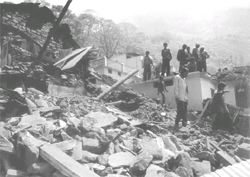Darkness at midnight
 given their magnitude, the tremors of the earthquake on March 29 that shook Chamoli region in Uttar Pradesh will continue for two more months. This was stated by H N Srivastava, scientist emeritus at the Indian Meteorological Department ( imd ). The quake, measuring 6.8 on the Richter scale, is said to be the most powerful one in the region during the last hundred years and lasted around 40 seconds. It left more than 100 people dead over 300 injured. Thousands of houses were reduced to rubble. Although the epicentre was Chamoli, the tremors were felt in places as far off as Pune in Maharashtra. The residents of Delhi were jolted out of their slumber and many multi-storey buildings in east Delhi developed cracks.
given their magnitude, the tremors of the earthquake on March 29 that shook Chamoli region in Uttar Pradesh will continue for two more months. This was stated by H N Srivastava, scientist emeritus at the Indian Meteorological Department ( imd ). The quake, measuring 6.8 on the Richter scale, is said to be the most powerful one in the region during the last hundred years and lasted around 40 seconds. It left more than 100 people dead over 300 injured. Thousands of houses were reduced to rubble. Although the epicentre was Chamoli, the tremors were felt in places as far off as Pune in Maharashtra. The residents of Delhi were jolted out of their slumber and many multi-storey buildings in east Delhi developed cracks.
An earthquake is a burst of energy that accumulates over the years in the weak zones in the Earth's crust called fault lines. The energy release is facilitated by the tectonic plate movement. In this case, the earthquake was a result of energy released due to the constant collision of the Indo-Australian tectonic plate with the Eurasian or Tibetan plate, says S K Srivastava, the director general of imd . Ever since the subcontinent separated from the African plate 180 million years ago, it has been moving in the north and northeast direction at the rate of five centimetres a year. The Himalaya came into being only 40 million years ago when the Indian plate collided with the Tibetan plate for the first time.
Chamoli region falls under the main fault line of the subcontinent plate. This phenomena has turned the Chamoli region or the Himalayan region into the most seismically active zone of India, says Srivastava. In this area, the accumulated energy becomes the epicentre of major earthquakes. In the last 12 years, it has experienced three major quakes.
Like the preceding earthquakes, this tragedy has served to remind us of the need for a scientific study of seismic activities and a comprehensive disaster management policy. Though India is one of four quake-prone areas of the world, it does not have a seismology policy or a specialised institute to study seismic activities. Countries like China and Nepal have national seismology policies and specialised institutes. India's seismic zoning map has not been updated since 1984. After major quakes like the ones in Latur and Uttarkashi, scientists have suggested updating and rearranging the present seismic zones. The B K Rao Committee, set up in 1993, recommended a national policy to manage seismic disasters and the need to appoint one chief seismologist to monitor all seismic studies.
